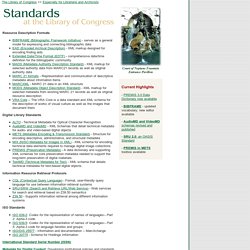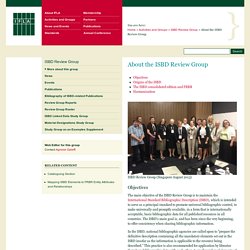

Cataloging and Acquisitions. Directory of OCLC Libraries. Search the MARC Code List for Organizations Database (Network Development and MARC Standards Office, Library of Congress)
HILCC. FAST (Faceted Application of Subject Terminology) Character sets. Catalog Enrichment. MARC. Amazon to Marc Converter. EAD, MARC and DACS. MarcEdit Development. Standards (The Library of Congress) Resource Description Formats BIBFRAME (Bibliographic Framework Initiative) - serves as a general model for expressing and connecting bibliographic data EAD (Encoded Archival Description) - XML markup designed for encoding finding aids Extended Date/Time Format (EDTF) - comprehensive date/time definition for the bibliogrpahic community MADS (Metadata Authority Description Standard) - XML markup for selected authority data from MARC21 records as well as original authority data MARC 21 formats - Representation and communication of descriptive metadata about information items MARCXML - MARC 21 data in an XML structure MODS (Metadata Object Description Standard) - XML markup for selected metadata from existing MARC 21 records as well as original resource description VRA Core -- The VRA Core is a data standard and XML schema for the description of works of visual culture as well as the images that document them Digital Library Standards Information Resource Retrieval Protocols ISO Standards.

About the ISBD Review Group. ISBD Review Group (Singapore August 2013) Objectives The main objective of the ISBD Review Group is to maintain the International Standard Bibliographic Description (ISBD), which is intended to serve as a principal standard to promote universal bibliographic control, to make universally and promptly available, in a form that is internationally acceptable, basic bibliographic data for all published resources in all countries.

The ISBD's main goal is, and has been since the very beginning, to offer consistency when sharing bibliographic information. In the ISBD, national bibliographic agencies are called upon to "prepare the definitive description containing all the mandatory elements set out in the ISBD insofar as the information is applicable to the resource being described. " This practice is also recommended for application by libraries that share bibliographic data with each other. Origins of the ISBD The ISBD consolidated edition and FRBR Harmonization.
FRBR. AACR2 > RDA. The difference between AACR, LOC, DDC, FRBR, CCO, MARC and RDA. OCLC - Web Dewey Logon. Appleton Public Library, WI. Dewey Decimal Classification / Linked Data. Dewey Decimal Classification System. 600 Technology (Applied sciences) 601 Philosophy & theory 602 Miscellany 603 Dictionaries & encyclopedias 604 Special topics 604.2 Technical drawing 604.7 Hazardous materials technology 605 Serial publications 606 Organizations 607 Education, research, related topics 608 Invention & patents 609 Historical, areas, persons treatment 610 Medical sciences; Medicine 610.6 Organizations, management, professions 610.7 Education, nursing, related topics 610.9 Historical, geographic, persons treatment 611 Human anatomy, cytology, histology 612 Human physiology 613 Promotion of health 614 Incidence & prevention of disease.

DDC 22. De la classification à facettes aux sérendipités documentaires. La lecture de l’excellent livre Introduction au sciences de l’information (voilà LE livre de référence pour tout étudiant en info-doc qui se respecte) m’a remis les idées en place sur Shiyali Ramamrita Ranganathan (1892 – 1972) ce mathématicien et bibliothécaire indien souvent cité comme l’inventeur des 5 lois des bibliothèques : 1 Les livres sont faits pour être utilisés 2 À chaque lecteur son livre 3 À chaque livre son lecteur 4 Épargnons le temps du lecteur 5 Une bibliothèque est un organisme en développement Ouais bon, personnellement je les ai jamais trouvées révolutionnaires ces lois, bien qu’elles soient bonnes à rappeler de temps à autre… En revanche, ce qu’on oublie que c’est que le Sieur Ranganathan est l’inventeur d’un système de classification à facettes, la Classification Colon (CC) qu’il finalise en 1933.

Sur Wikipédia : Il y a dans ces 5 éléments (nan rien à voir avec le film), la quête du graal : la syntaxe absolue, celle des méta-données fondamentales. An Experimental Classification Service. Enter an ISBN, OCLC#, UPC, or ISSN Standard Number: An ISBN is a unique number assigned to an item by its publisher.

Each ISBN is a 10 or 13 digit number. Thirteen-digit ISBNs must begin with either 978 or 979. Enter ISBNs with our without hyphens. For example; The International ISBN Agency. Library Barcodes Explained. Beginning in the mid to late 1970s, barcodes began to replace punched cards and manual checkout slips at many major university and public libraries.

The CLSI company of Boston, Massachusetts, which was later acquired by Geac Computers, of Markham, Ontario, developed the standard 14-digit Codabar labels currently used in many of these libraries around the world. The CLSI Standard replaced the Plessey standard, which had been used widely, as well as many locally-developed schemes. The label begins with a single digit representing the type of entity being described: special command to the library system software a person (i.e. a library patron, staff member...) An item (i.e. a particular copy of a book, tape, disk...) Next comes a 4-digit "agency prefix", which represents the library which owns the item, or to which the patron belongs. The next eight digits are unique to the item upon which the label has been placed.
Finally, the last digit is a "modulus 10 checksum". 1. International Paper Sizes, Formats & Standards Explained. Special Libraries Cataloguing, Inc.